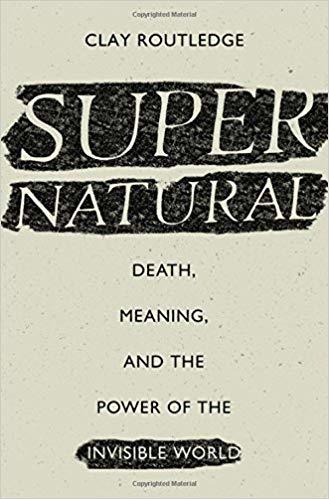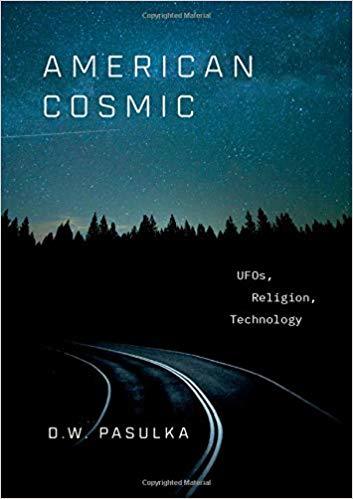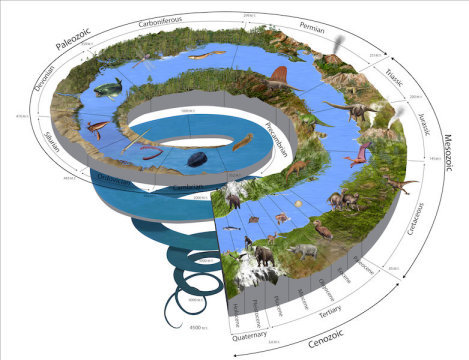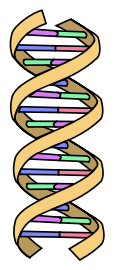Michael J. Behe's Blog, page 470
June 10, 2019
Fastest known bite in the animal kingdom?
It takes roughly 1/6000 of a second.
The speed of a hairy frogfish’s bite is the result of a vacuum in its mouth that can suck in its prey in just 1/6000th of a second. It’s so fast that even slow-motion video struggles to capture it.
In 2006, researchers also noted a swift predatory ant:
Biologists clocked the speed at which the trap-jaw ant, Odontomachus bauri, closes its mandibles at 35 to 64 meters per second, or 78 to 145 miles per hour – an action they say is the fastest self-powered predatory strike in the animal kingdom. The average duration of a strike was a mere 0.13 milliseconds, or 2,300 times faster than the blink of an eye. “” at UCal Berkeley
Yes, we’re going back to work too. 
June 9, 2019
Atheists suffer apocalypse anxiety too, it seems

Behavioral scientist Clay Routledge, author of Supernatural: Death, Meaning, and the Power of the Invisible World, explains:
Routledge suggested the behaviour of religious doomsday fretters was similar to atheist political activists. ‘I’m increasingly seeing a similar sort of fatalism on the secular left,’ he continued. ‘I’ve seen people promoting anti-natalism [the concept that having babies is wrong] because they believe the world is a horrible place and is going to be destroyed in the near future by climate change and that this fate is unavoidable. ‘This makes me think there are some fatalistic similarities between extreme groups of religious fundamentalists and leftwing secular fundamentalists.’
Jasper Hamill, “We’re in an age of ‘apocalypse anxiety’ and will never stop worrying about doomsday” at METRO
Here’s how anxiety will get worse: Wait till space aliens become a new majority religion: Nearly as many young Americans believe in ET as in God, says religion prof. Popular culture is looking for high-tech ETs to be its saviors and Silicon Valley aspires to become those ETs. What could possibly go wrong?
Follow UD News at Twitter!
Copyright © 2019 Uncommon Descent . This Feed is for personal non-commercial use only. If you are not reading this material in your news aggregator, the site you are looking at is guilty of copyright infringement UNLESS EXPLICIT PERMISSION OTHERWISE HAS BEEN GIVEN. Please contact legal@uncommondescent.com so we can take legal action immediately.
Plugin by Taragana
Nearly as many young Americans believe in ET as in God

Says religion prof:
As for why humans might be more willing to embrace this new “religion” of alien belief now than in the past, Pasulka says advances in space exploration play a role — but she also thinks an increasing belief that our planet is headed toward a crisis factors into the equation.
“A lot of people see disaster on the horizon, and there’s a deep fear that we won’t be able to save ourselves,” she told Vox. “So what will save us? Well, for some, it will be these advanced beings who come to us and tell us what we can do or how we can escape.”
Kristin Houser, “Professor: belief in aliens could replace traditional religion ” at Futurism
It’s the topic of her new book, American Cosmic: UFOs, Religion, Technology, whose blurb reads, “More than half of American adults and more than seventy-five percent of young Americans believe in intelligent extraterrestrial life. This level of belief rivals that of belief in God.”News, “Will space aliens become a new majority religion?” at Mind Matters News
The story gets wilder and involves space scientists who are UFO enthusiasts, blindfolds, and all.
As for the kids, if her figures are correct, they should have watched more sci-fi dystopias.
The good news is that there probably aren’t any space aliens out there so they will only have to live in a dystopia they made themselves, not a different one.
See also: Tales of an invented god
Follow UD News at Twitter!
Copyright © 2019 Uncommon Descent . This Feed is for personal non-commercial use only. If you are not reading this material in your news aggregator, the site you are looking at is guilty of copyright infringement UNLESS EXPLICIT PERMISSION OTHERWISE HAS BEEN GIVEN. Please contact legal@uncommondescent.com so we can take legal action immediately.
Plugin by Taragana
Educator proposes a more humane way to teach evolution
 Michael Reiss
Michael ReissMichael Reiss, who got bounced as Director of Education at the Royal Society in 2008, in a row over teaching evolution, has some suggestions:
I propose that a way forward may be to teach evolution as a sensitive issue.
A teacher who approaches evolution in this way is respectful of their students’ beliefs and attentive to their emotional states, rather than dismissing them as “silly”, “ignorant” or “causing problems”. Such teachers would employ teaching approaches that embrace diversity, address classroom bias, and hold in conscious awareness the individual experiences of students. These techniques are commonly used when teaching sensitive issues such as sex, pornography, ethnicity, religion, death studies, terrorism, and others.
Teachers would still cover the full range of content when teaching evolution. However, when, for example, teaching about how humans and other mammals share a common ancestor, they would not actively seek to establish agreement among all students. When running a group exercise about the age of the Earth, they might use clicker technology that anonymises responses.
Michael Reiss, “Evolution: as a religious professor of science education, we need to rethink how we teach it” at The Conversation
In 2008, Reiss ended up resigning from a Royal Society post because of an earlier effort to make Darwinism sound reasonable. Or something.
By and large, the Darwinians are not interested in sounding reasonable; they are interested in enforcing their view. And, as everyone knows, the school textbook is the last stronghold of simple-minded Darwinism.
In any event, the critical question is not whether we are nice to doubters so much as whether there is reason to doubt. Contrary to what we hear in pop science media, quite a few scientists think there is.
At least he sounds like a decent man, trying to be civilized. Lot of good that will do him, sadly.
See also: Michael Reiss: Sinner in the hands of an angry god
and
David Tyler On Michael Reiss, The Anglican Cleric Somehow Dumped For Insufficient Darwinism
Follow UD News at Twitter!
Copyright © 2019 Uncommon Descent . This Feed is for personal non-commercial use only. If you are not reading this material in your news aggregator, the site you are looking at is guilty of copyright infringement UNLESS EXPLICIT PERMISSION OTHERWISE HAS BEEN GIVEN. Please contact legal@uncommondescent.com so we can take legal action immediately.
Plugin by Taragana
Continuing efforts to erase the beginning of time
 Big Bang/NASA
Big Bang/NASAFollowing up on the
survival of Stephen Hawking’s here’s another effort to eliminate a beginning :
When we think about our cosmic origins, then, it’s only human to ask the most fundamental of all possible questions: where did this all come from? It’s been more than half a century since the first robust and unique predictions of the Big Bang were confirmed, leading to our modern picture of a Universe that began from a hot, dense state some 13.8 billion years ago. But in our quest for the beginning, we know already that time couldn’t have started with the Big Bang. In fact, it might not have had a beginning at all…
Thousands of years after we laid out the three major possibilities for how time began — as having always existed, as having begun a finite duration ago in the past, or as being a cyclical entity — we are no closer to a definitive answer. Whether time is finite, infinite, or cyclical is not a question that we have enough information within our observable Universe to answer. Unless we figure out a new way to gain information about this deep, existential question, the answer may forever be beyond the limits of what is knowable. Ethan Siegel, “Did Time Have A Beginning?” at Forbes
It’s quite clear that Siegel’s objection to the idea of a beginning to the universe is philosophical. Most of the nonsense one hears, genrlaly, can be traced to unwillingness to admit that.
Follow UD News at Twitter!
See also: Hawking’s idea that the universe had no beginning is still alive, on life support At Quanta: After two years of sparring, the groups have traced their technical disagreement to differing beliefs about how nature works.
and
The Big Bang: Put simply,the facts are wrong.
Copyright © 2019 Uncommon Descent . This Feed is for personal non-commercial use only. If you are not reading this material in your news aggregator, the site you are looking at is guilty of copyright infringement UNLESS EXPLICIT PERMISSION OTHERWISE HAS BEEN GIVEN. Please contact legal@uncommondescent.com so we can take legal action immediately.
Plugin by Taragana
Fine-tuning of the universe: Pro and con
Dr. Robin Collins, Dr. Josh Rasmussen, and Cameron Bertuzzi have a casual conversation about the fine-tuning argument. We discuss the strongest versions, strongest objections, and take questions from viewers.
Follow UD News at Twitter!
See also: What becomes of science when the evidence does not matter? As in the case of fine-tuning.
Copyright © 2019 Uncommon Descent . This Feed is for personal non-commercial use only. If you are not reading this material in your news aggregator, the site you are looking at is guilty of copyright infringement UNLESS EXPLICIT PERMISSION OTHERWISE HAS BEEN GIVEN. Please contact legal@uncommondescent.com so we can take legal action immediately.
Plugin by Taragana
William Lane Craig vs. Ronald DeSousa: Difference between humans and orangutans
William Lane Craig takes it on, against an atheist who sees no difference:
Yes, language makes the difference but … it’s what language is about that matters. As WLC explains, DeSousa takes back with the right hand what he gives with the left.
Hat tip: Ken Francis
Note: The book DeSousa is talking about is probably Why Think?: Evolution And The Rational Mind
See also: Cats DO — as signals, not as abstractions
Follow UD News at Twitter!
Copyright © 2019 Uncommon Descent . This Feed is for personal non-commercial use only. If you are not reading this material in your news aggregator, the site you are looking at is guilty of copyright infringement UNLESS EXPLICIT PERMISSION OTHERWISE HAS BEEN GIVEN. Please contact legal@uncommondescent.com so we can take legal action immediately.
Plugin by Taragana
Machines won’t think like people—how do we deal with the disappointment?
 Jonathan Bartlett
Jonathan BartlettJonathan Bartlett (our johnnyb) offers some thoughts on a new model of machine intelligence:
So they won’t think like people but it will seem that way.
If you read between the lines, the “new model” of general AI being proposed is that we won’t develop a general AI. Framing this as a “new model” of general AI is simply to avoid being labeled as a pessimist.
Jonathan Bartlett, “How do you explain that machines won’t really think like people?” at Mind Matters News
Follow UD News at Twitter!
See also: See also: Why I doubt that AI can match the human mind (Jonathan Bartlett)
If you think common sense is easy to acquire. Try teaching it to a state-of-the-art self-driving car. Start with snowmen. (Brendan Dixon)
and
Could AI think like a human, given infinite resources? (Eric Holloway)
Copyright © 2019 Uncommon Descent . This Feed is for personal non-commercial use only. If you are not reading this material in your news aggregator, the site you are looking at is guilty of copyright infringement UNLESS EXPLICIT PERMISSION OTHERWISE HAS BEEN GIVEN. Please contact legal@uncommondescent.com so we can take legal action immediately.
Plugin by Taragana
June 8, 2019
New Ordovician) fossils (470 to 459 million years ago) show survival of “extinct” life forms
 The Ordovician is at the mid-left/
The Ordovician is at the mid-left/ © nicolasprimola / Adobe Stock
From ScienceDaily:
“Before this, there had been nothing found on the Iberian Peninsula in the Ordovician that even resembled these,” Kimmig said. “They close a gap in time and space. And what’s very interesting is the kind of fossils. We find Medusozoa — a jellyfish — as well as animals which appear to be wiwaxiids, which are sluglike armored mollusks that have big spines. We found these lateral sclerites of animals which were actually thought to have gone extinct in the late Cambrian. There might have been some that survived into the Ordovician in a Morocco deposit, but nothing concrete has been ever published on those. And here we have evidence for the first ones actually in the middle of the Ordovician, so it extends the range of these animals incredibly.”
Kimmig said the discovery of uncommon wiwaxiids fossils in this time frame suggests the animals lived on Earth for a far greater span of time than previously understood.
“Especially with animals that are fairly rare that we don’t have nowadays like wiwaxiids, it’s quite nice to see they lived longer than we ever thought,” he said. “Closely after this deposit, in the Upper Ordovician, we actually get a big extinction event. So, it’s likely the wiwaxiids survived up to that big extinction event and didn’t go extinct earlier due to other circumstances. But it might have been whatever caused the big Ordovician extinction event killed them off, too.”Paper. (paywall) – Julien Kimmig, Helena Couto, Wade W. Leibach, Bruce S. Lieberman. Soft-bodied fossils from the upper Valongo Formation (Middle Ordovician: Dapingian-Darriwilian) of northern Portugal. The Science of Nature, 2019; 106 (5-6) DOI: 10.1007/s00114-019-1623-z More.
They are naturally hoping for more fossils. Extinction, generally, seems to take longer than we sometimes suppose.
See also: Ars Technica: Ars Technica: Ordovician Period “Even Crazier” Than The Cambrian
Follow UD News at Twitter!
Copyright © 2019 Uncommon Descent . This Feed is for personal non-commercial use only. If you are not reading this material in your news aggregator, the site you are looking at is guilty of copyright infringement UNLESS EXPLICIT PERMISSION OTHERWISE HAS BEEN GIVEN. Please contact legal@uncommondescent.com so we can take legal action immediately.
Plugin by Taragana
Supposed junk DNA serves as microlens for condensing light

A new study, we are told,”turns our picture of the nucleus upside down”:
Eukaryotic chromosomes are built of chromatin, a complex of DNA and associated proteins. Depending on transcriptional activity and degree of compaction, two types of chromatin can be distinguished and these two types are spatially separated within the nucleus. The highly condensed fraction is made up of regions of chromatin that contain few genes and is transcriptionally inactive. It is called heterochromatin, and is located in the periphery of the nucleus, close to the nuclear membrane. Euchromatin, on the other hand, is enriched in genes and corresponds to the active fraction of the genome. It occupies the inner regions of the nucleus, is less densely packed, and therefore more accessible to the protein machineries required for gene expression. This general pattern of genome organization is found in virtually all eukaryotic cell types…
… In rods, the tightly condensed heterochromatin is packed in the interior of the nuclei, while the active euchromatin is localized directly under the nuclear membrane—a unique exception to the general rule. It turned out that the heterochromatin core of rod nuclei serves as a microlens condensing light and thus improving optical properties in the nocturnal retinas….
“What organizes the genome in the nucleus?” at Ludwig Maximilian University of Munich
Hat tip: Philip Cunningham
Cunningham notes that Rick Steinberg commented on this kind of thing a decade ago:
Reporting in the journal Cell, Irina Solovei and coworkers have just discovered that, in contrast to the nucleus organization seen in ganglion and bipolar cells of the retina, a remarkable inversion of chromosome band localities occurs in the rod photoreceptors of mammals with night vision (Solovei I, Kreysing M, Lanctôt C, Kösem S, Peichl L, Cremer T, Guck J, Joffe B. 2009. “Nuclear Architecture of Rod Photoreceptor Cells Adapts to Vision in Mammalian Evolution.” Cell 137(2): 356-368). First, the C-bands of all the chromosomes including the centromere coalesce in the center of the nucleus to produce a dense chromocenter. Keep in mind that the DNA backbone of this chromocenter in different mammals is repetitive and highly species-specific. Second, a shell of LINE-rich G-band sequences surrounds the C-bands. Finally, the R-bands including all examined protein-coding genes are placed next to the nuclear envelope. The nucleus of this cell type is also smaller so as to make the pattern more compact. This ordered movement of billions of basepairs according to their “barcode status” begins in the rod photoreceptor cells at birth, at least in the mouse, and continues for weeks and months. Why the elaborate repositioning of so much “junk” DNA in the rod cells of nocturnal mammals? The answer is optics. A central cluster of chromocenters surrounded by a layer of LINE-dense heterochromatin enables the nucleus to be a converging lens for photons, so that the latter can pass without hindrance to the rod outer segments that sense light. In other words, the genome regions with the highest refractive index — undoubtedly enhanced by the proteins bound to the repetitive DNA — are concentrated in the interior, followed by the sequences with the next highest level of refractivity, to prevent against the scattering of light. The nuclear genome is thus transformed into an optical device that is designed to assist in the capturing of photons. This chromatin-based convex (focusing) lens is so well constructed that it still works when lattices of rod cells are made to be disordered. Normal cell nuclei actually scatter light. So the next time someone tells you that it “strains credulity” to think that more than a few pieces of “junk DNA” could be functional in the cell — that the data only point to the lack of design and suboptimality — remind them of the rod cell nuclei of the humble mouse.
Rick Steinberg (April 29, 2009), “Shoddy Engineering or Intelligent Design? Case of the Mouse’s Eye” at Evolution News and Science Today
Paper. (paywall)
See also: Humans may have only 19,000 coding genes
“Junk DNA” regulates regeneration of tissues and organs
Note: One junk DNA defender just isn’t doing politeness anymore. Hmmm. In a less Darwinian science workplace, that could become more a problem for him than for his colleagues.
Junk DNA can actually change genitalia. Junk DNA played the same role in defending Darwinian evolution as claims that Neanderthal man was a subhuman. did: The vast library of junk genes and the missing link made Darwin’s story understandable to the average person and the missing link even became part of popular culture. With Darwinism so entrenched, the fact that these beliefs are not based on fact will be difficult to root out of the culture. Darwin-only school systems are part of the problem.
Been a while since we’ve heard much about humans as the 98% or 99% chimpanzee. If the human genome is this fuzzy how would we know? And doubtless, things have gotten more complex.
At Quanta: Cells need almost all of their genes, even the “junk DNA”
“Junk” RNA helps regulate metabolism
Junk DNA defender just isn’t doing politeness any more.
Anyone remember ENCODE? Not much junk DNA? Still not much. (Paper is open access.)
Yes, Darwin’s followers did use junk DNA as an argument for their position.
Another response to Darwin’s followers’ attack on the “not-much-junk-DNA” ENCODE findings
Follow UD News at Twitter!
Copyright © 2019 Uncommon Descent . This Feed is for personal non-commercial use only. If you are not reading this material in your news aggregator, the site you are looking at is guilty of copyright infringement UNLESS EXPLICIT PERMISSION OTHERWISE HAS BEEN GIVEN. Please contact legal@uncommondescent.com so we can take legal action immediately.
Plugin by Taragana
Michael J. Behe's Blog
- Michael J. Behe's profile
- 219 followers



